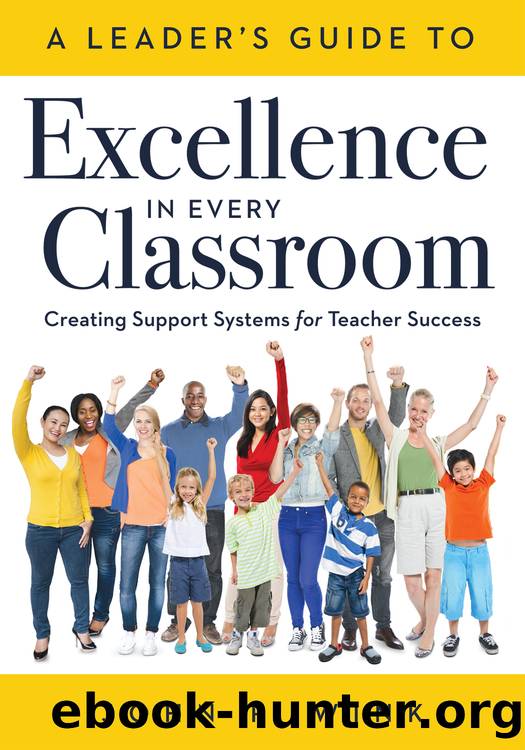Leader's Guide to Excellence in Every Classroom by Wink John R.;

Author:Wink, John R.;
Language: eng
Format: epub
Publisher: Solution Tree
Published: 2017-08-15T00:00:00+00:00
Source: Adapted from Fisher & Frey, 2008.
Figure 5.3: Gradual release of responsibility.
Beyond guiding students to assume responsibility for their own learning processes, teachers can also build student engagement by demonstrating their own interest and engagement as they deliver learning content and guide learning experiences. As Heather Wolpert-Gawronâs (2015) students note:
Instead of talking like a robot, teachers should speak to us like theyâre really passionate about teaching. . . . If a teacher acts like this is the last thing they want to be doing, the kids will respond with the same negative energy. If you act like you want to be there, then we will too.
In essence, teachers build student engagement by delivering lesson content in a way that actively and enthusiastically involves students in the learning process. By gradually transitioning responsibility for those processes to the students, teachers not only help promote their learnersâ cognitive investment in learning the content but also can boost studentsâ perceptions of that contentâs relevance to their own interests. Further, they demonstrate trust in the studentsâ competence and control in the learning process. By structuring class time within a framework of introductions to content and its associated models of thinking, guided interactive activities, collaborative group work, and independent study, teachers can be certain that they are filling the majority of class time with productive learning activities.
The lesson-planning template in figure 5.4 (pages 100â101) is a collaborative tool to help teachers plan and deliver content by keeping the focus on relevance, responsibility, and optimized time. By using Google Sheets, teachers and leaders can view, edit, and use the comment feature to have asynchronous dialogue about a teacherâs plans for student engagement. Leaders can use the lesson-planning template as a walkthrough instrument to give teachers targeted feedback on how well their plans align with their instructional delivery and identify where they successfully promote engagement, miss opportunities for engagement, or actually add to disengagement in the classroom.
When teachers leverage student interests, cultural affinities, and existing competencies, they can creatively design engaging lessons that intentionally advance learning targets through various components of engagement: student-directed learning, productive group collaboration, active independent study, and other classroom activities. When the preparation for engagement is detailed and aligned to the nature and needs of students, teachers can expect to see an increase in the ownership of and pride in the learning process. By planning lessons designed to accomplish learning goals and align with student abilities and interests, teachers are well positioned to connect students with their learning and to inspire them to want to know more about the content.
Download
This site does not store any files on its server. We only index and link to content provided by other sites. Please contact the content providers to delete copyright contents if any and email us, we'll remove relevant links or contents immediately.
Macmillan Primary Grammar 2 Pupil's Book by Unknown(400)
Figuring Out Fluency in Mathematics Teaching and Learning, Grades K-8 by Jennifer M. Bay-Williams & John J. SanGiovanni(362)
The Principal's Guide to Curriculum Leadership by Sorenson Richard D.;Goldsmith Lloyd M.;Mendez Zulma Y.;Maxwell Karen T.;(288)
Learning from Accidents 3rd ed by Trevor Kletz (2001)(251)
English Grammar Practice--The Noun by Roxana Nastase(247)
Harnessing Technology for Deeper Learning by Scott McLeod(242)
Text-Dependent Questions, Grades K-5 by Douglas Fisher & Nancy Frey & Heather Anderson & Marisol Thayre(226)
A Guide to Curriculum Mapping by Hale Janet A.;(223)
English Language Program Administration by Unknown(216)
How to Do Everything with Google Tools by Unknown(209)
Deep Change Leadership by Reeves Douglas;(204)
The Grammar Teacher's Activity-a-Day by Jack Umstatter(194)
The Power of SMART Goals by Conzemius Anne;O'Neill Jan; & Anne Conzemius(188)
Beyond the RTI Pyramid by Bender William N.;(170)
Aligning and Balancing the Standards-Based Curriculum by Squires David A.;(169)
Using Data to Close the Achievement Gap by Johnson Ruth S.;(162)
Differentiated Instructional Strategies for the Block Schedule by Gregory Gayle H.;Herndon Lynne E.; & Lynne E. Herndon(161)
Using Equity Audits to Create Equitable and Excellent Schools by Skrla Linda E.;McKenzie Kathryn B.;Scheurich James Joseph;(161)
You've Got to Reach Them to Teach Them by Schreck Mary Kim; & Schreck(154)
